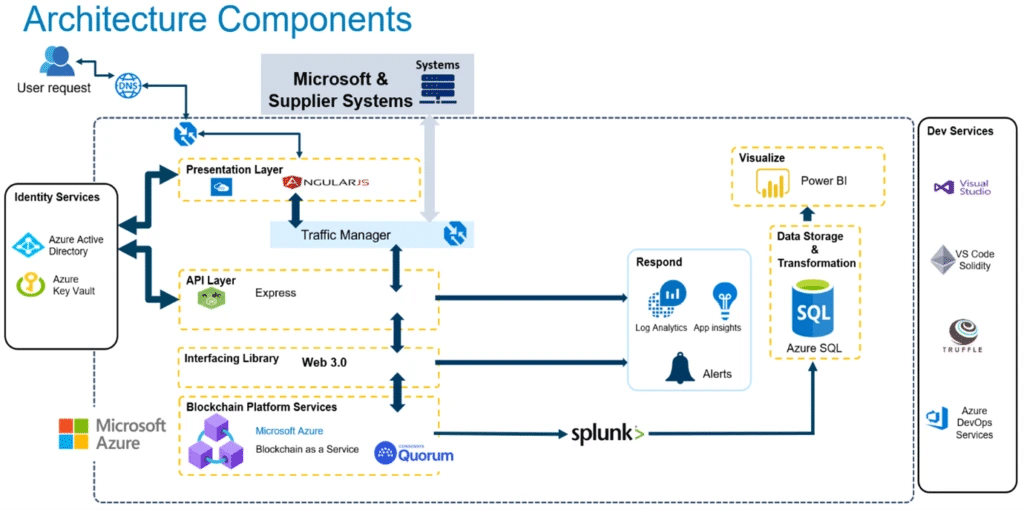In today’s globalized economy, supply chains have become increasingly complex, spanning multiple countries and involving numerous stakeholders. This complexity often leads to inefficiencies, lack of transparency, and difficulties in tracing products from origin to destination. Blockchain technology has emerged as a powerful tool to address these challenges, offering enhanced transparency and traceability across supply chains. Originally developed as the underlying technology for cryptocurrencies like Bitcoin, blockchain has found a natural fit in supply chain management due to its core properties of immutability, decentralization, and transparency.
What is Blockchain Technology?
At its core, blockchain is a distributed ledger that records transactions across multiple computers in a way that ensures the data is secure, transparent, and unchangeable. Each transaction or event in the blockchain is stored in a “block,” which is then linked to the previous one, creating a “chain” of blocks. The ledger is distributed across all participants (nodes) in the network, which means no single party controls the data. Once data is added to the blockchain, it cannot be altered without the consensus of the entire network.
Challenges in Traditional Supply Chains
Traditional supply chains are often opaque and fragmented. Goods travel across multiple intermediaries—from suppliers and manufacturers to logistics providers and retailers—each maintaining their own records. This siloed approach makes it difficult to trace the journey of products in real time, leading to inefficiencies, fraud, counterfeiting, and a lack of trust among stakeholders.
For instance, consumers may not know whether the food they buy is ethically sourced, companies may find it challenging to detect where product defects occurred, and regulatory bodies may struggle to ensure compliance with standards. In this complex environment, blockchain’s ability to provide end-to-end traceability and transparency offers a powerful solution.
Blockchain’s Role in Supply Chain Transparency and Traceability

Blockchain can bring transformative improvements in the following ways:
- Enhanced Traceability: By storing all transactions and movements of goods in a tamper-proof ledger, blockchain makes it possible to track products from their point of origin to the consumer.
- Transparency Across All Stakeholders: Every participant in the supply chain has access to the same data, reducing the risk of misinformation and ensuring greater accountability.
- Increased Trust: Since data in the blockchain cannot be altered or deleted, the technology helps build trust between consumers, regulators, and businesses.
- Reduction in Counterfeiting and Fraud: Blockchain allows for the verification of authenticity, ensuring that goods such as luxury items or pharmaceuticals are genuine.
- Compliance and Sustainability: Blockchain can ensure adherence to regulations, standards, and sustainability commitments by providing a reliable record of the journey of raw materials and finished products.
How Blockchain Works in Supply Chain

In a blockchain-enabled supply chain, every movement of a product—from sourcing to delivery—is recorded on the blockchain as a transaction. These transactions form a decentralized ledger, where each participant in the supply chain network has access to the same immutable data. Below are the key technical elements that explain how blockchain works in this context:
- Distributed Ledger Technology (DLT): Blockchain is a type of DLT, where the data is distributed across multiple nodes (computers) instead of being stored in a single central location. This decentralization ensures that all participants in the supply chain have access to the same data in real-time, reducing the possibility of data tampering or manipulation.
- Smart Contracts: A crucial component of blockchain technology in supply chains is smart contracts—self-executing contracts with the terms of the agreement directly written into code. In supply chain management, smart contracts automate various business processes, such as payments, quality checks, and compliance verifications. For example, when a product reaches a specific point in the supply chain, a smart contract can automatically trigger a payment or confirm delivery without the need for intermediaries.
- Consensus Mechanisms: Blockchain networks use consensus mechanisms to ensure that all participants in the network agree on the validity of transactions. In supply chain applications, this ensures that all recorded events—such as shipping confirmations, quality checks, and payments—are agreed upon by all parties. Common consensus mechanisms include:
- Proof of Work (PoW): Used in more energy-intensive networks like Bitcoin, though less common in supply chain solutions.
- Proof of Stake (PoS): More energy-efficient and scalable, increasingly adopted in supply chain blockchains.
- Practical Byzantine Fault Tolerance (PBFT): Common in permissioned blockchains used for supply chains, where participants are known and trusted.
- Cryptographic Hashing: Blockchain uses cryptographic hashing to ensure data integrity. Every block in the blockchain contains a cryptographic hash of the previous block, along with its transaction data. This chain of blocks ensures that any attempt to alter a block’s data would invalidate the entire chain. In supply chains, this ensures that product information, such as origin and quality checks, cannot be altered after being recorded.
- Permissioned vs. Permissionless Blockchain: In supply chain scenarios, permissioned blockchains are often used, where only authorized participants (e.g., suppliers, manufacturers, logistics providers, retailers) can join the network. This contrasts with permissionless blockchains like Bitcoin, where anyone can participate. Permissioned blockchains offer better control, security, and scalability for enterprise use cases.
Blockchain Use in Supply Chain
Nestlé (Coffee Supply Chain Transparency)
- Use Case: Nestlé adopted blockchain to increase transparency in its coffee supply chain, ensuring that consumers can trace the source of the coffee they drink.
- Challenge: The coffee supply chain is complex, involving multiple intermediaries, which makes it hard for Nestlé to verify where the beans were sourced and whether fair trade practices were followed.
- Blockchain Impact: With blockchain, Nestlé provides transparency to consumers by allowing them to track the entire journey of the coffee, from farm to shelf. This supports sustainability and fair trade initiatives.
Anheuser-Busch InBev (Reducing Supply Chain Fraud)
- Use Case: Anheuser-Busch InBev, the world’s largest brewer, uses blockchain to increase transparency and reduce fraud in its supply chain, particularly when sourcing raw materials.
- Challenge: The beer giant struggled with ensuring that raw materials, such as barley, were sourced according to agreed-upon contracts without fraud or manipulation.
- Blockchain Impact: By adopting blockchain, the company can track every step of the procurement process, ensuring that suppliers follow their contracts. This helps reduce fraud and promotes fair trading practices across its global supply chain.
PharmaLedger Consortium (Pharmaceutical Supply Chain)
- Use Case: PharmaLedger, a consortium of leading pharmaceutical companies (including Novartis and Merck), uses blockchain to track medicines across the supply chain, ensuring authenticity and reducing counterfeit drugs.
- Challenge: Counterfeit drugs pose a major health risk, and ensuring that medications come from certified manufacturers is crucial.
- Blockchain Impact: With blockchain, PharmaLedger allows pharmacies and hospitals to verify the authenticity of drugs in real time, reducing the risk of counterfeit medications entering the market and ensuring patient safety.
Blockchain Use in Other Industries

Banking:
- JPMorgan Chase developed the Interbank Information Network (IIN) using blockchain technology to streamline cross-border payments and reduce the time and costs associated with interbank transactions.
- trade is a blockchain-based trade finance platform developed by a consortium of major banks, including HSBC and Deutsche Bank.
Luxury Goods:
· LVMH, in collaboration with Prada Group and Cartier, launched the AURA Blockchain Consortium.
Shipping and Logistics:
- Blockchain allows FedEx to create an immutable record of shipment data, which can be accessed by all parties involved in the transportation process.
Fashion:
- Provenance is a blockchain-based platform that allows fashion brands and retailers to provide consumers with verifiable claims about the sustainability and ethical sourcing of their products.
Diamonds:
- De Beers, one of the largest diamond mining companies in the world, has implemented blockchain to track the journey of diamonds from mine to consumer.
Mining Supply Chain:
- BHP Billiton, one of the world’s largest mining companies, uses blockchain to track and record data throughout the mining process.
Common Tech Stack Elements Used Across Industries:

· Blockchain Platform:
A Hyperledger Fabric-based solution was the core blockchain platform for all four companies.
· Cloud Computing:
Cloud was the primary infrastructure used to host blockchain operations and manage the data processing workloads.
· Smart Contracts:
All companies used smart contracts on Hyperledger Fabric to automate processes such as payment release, compliance verification, and condition monitoring in their supply chains.
· IoT Sensors:
Integration of IoT devices (sensors) was essential for real-time data capture on environmental conditions during transportation and storage, ensuring transparency and traceability.
· User Interface and QR Codes:
Each company provided QR code scanning capabilities that allowed consumers to access the blockchain data via web or mobile apps, creating a seamless interaction experience.
This technological infrastructure empowered these companies to ensure transparency, enhance product traceability, and meet consumer demand for greater visibility into food sourcing and supply chains.
Integrating Blockchain with Other Technologies
In modern supply chains, blockchain often works in conjunction with other technologies to optimize efficiency and deliver end-to-end visibility:
- Internet of Things (IoT): IoT devices, such as sensors and RFID tags, are integrated with blockchain to provide real-time data about the location, temperature, and condition of products. For example, a temperature sensor in a refrigerated truck can send data to the blockchain, ensuring that perishable goods are stored properly throughout their journey.
- Artificial Intelligence (AI): AI algorithms can analyze blockchain data to predict supply chain disruptions, optimize routes, and improve inventory management.
- Cloud Computing: Blockchain nodes and applications are often hosted in the cloud for scalability and ease of deployment.
Challenges and Future Outlook
While blockchain shows great promise in enhancing supply chain transparency and traceability, several challenges remain:
- Scalability: As more participants join blockchain networks, ensuring system performance and scalability becomes crucial.
- Interoperability: Different blockchain platforms need to communicate with each other seamlessly.
- Data privacy: Balancing transparency with the need for data privacy and protection remains a concern.
- Adoption and integration: Widespread adoption requires overcoming resistance to change and integrating blockchain with existing systems.
Implementation Strategies
- Stakeholder Engagement: Successful implementation requires buy-in from all stakeholders. Engaging suppliers, distributors, and customers early in the process is crucial.
- Pilot Programs: Start with pilot programs to test the technology and iron out any issues before full-scale implementation.
- Integration with Existing Systems: Ensure that blockchain solutions can integrate seamlessly with existing supply chain management systems to avoid disruptions.
- Regulatory Compliance: Work closely with regulatory bodies to ensure that blockchain implementations meet all legal and compliance requirements.
The adoption of blockchain technology in supply chain management represents a paradigm shift in how businesses approach transparency, traceability, and trust. From global retail giants to niche luxury brands, the diverse applications of blockchain demonstrate its versatility and transformative potential. As these pilot projects evolve into full-scale implementations, we stand on the cusp of a new era in supply chain management—one where transparency is not just a buzzword, but a tangible reality. The ripple effects of this transformation extend beyond operational efficiencies, touching on critical issues such as sustainability, ethical sourcing, and consumer empowerment. As blockchain technology continues to mature, it promises to reshape not just how products move from producer to consumer, but how trust and information flow throughout the global economy.
Read more:
IQAX: Paperless Bill of Lading Pioneer
Your Identity on Blockchain: Now Your Personal Data is Finally Safe

I am a Digital Transformation Consultant with over 25 years of experience across banking, finance, healthcare, retail, Industry 4.0, and government sectors. I specialize in designing data-driven digital transformation strategies and building roadmaps that enhance business value and promote people-centric excellence. I founded Transform Partner in London, UK, which reflects my passion for entrepreneurship and extensive experience in leveraging modern technologies to address market challenges. My work includes leading digitization and digital transformation projects for Saudi Arabia’s Vision 2030 and the UAE’s Digital Strategy 2025. Additionally, I serve as an executive advisor and coach for corporate learning and ‘Knowledge Transfer’ workshops.








